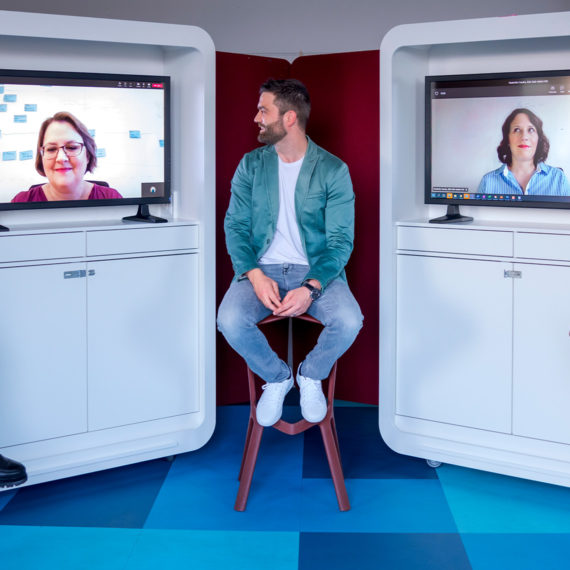Are companies best advised to hold their meetings online or in person? The answer is: it depends on the content. Read on for advice on organising meetings.
For a long time, the conference room was considered the obvious venue for all types of meetings. Then almost just as naturally, we got used to purely online meetings with headphones and laptop cameras during the pandemic. Many companies now offer hybrid arrangements, with employees switching between working from the office and at home. The question remains: should meetings be held online or on-site? Both approaches have their advantages.
The benefits of online meetings
In companies where employees work in different places – in the office, in the field, from home, etc. – virtual meetings have an invaluable advantage: everyone can participate, regardless of location. This makes it more straightforward to involve people who are rarely available in the office. Communicating with an external graphic designer, salesperson or busy boss is easier online.
And there’s technical support in the form of communication tools such as Zoom and Microsoft Teams. Chat functions, digital whiteboards and presentation options (screen sharing) are all useful discussion aids. And last but not least, online meetings save travel time, which can have a positive environmental impact.
In the case of hybrid meetings, some participants meet face to face while others attend online. The challenge here is to integrate the online participants. Tools such as conference systems and interactive whiteboards can help with this.
The benefits of on-site meetings
There are situations in which in-person meetings are easier. Taking notes on Post-its or a physical whiteboard is often more efficient than using their digital counterparts. Above all, however, we tend to be much better at picking up on individual participants’ body language in face-to-face meetings than in the small images captured by laptop cameras.
Spontaneous, informal meetings in the hallway or in front of the coffee machine also require us to be physically present with each other. The pandemic has shown just how much we miss this kind of interaction when it is no longer possible. The flow of information deteriorates and there’s a lack of social contact.
Which meetings should be held where?
The benefits of in-person and online meetings can be used to determine which format is most appropriate and when. If the focus is on work, online is the right choice. Planning and coordination meetings can be held virtually just as easily as a company-wide information event with many participants.
On the other hand, if the focus is on people – meaning that body language is important – on-site meetings are the preferred option. This is even more true if the parties involved don’t know each other well. Job and salary interviews, team meetings, strategic planning, brainstorming and team-building activities belong in the meeting room. As do challenging discussions where participants disagree (and can hopefully reach an agreement).
Perhaps no meeting is best?
Sometimes there’s no need to ask how and where. Many people who work in an office complain about having too many meetings. A solution can be found by keeping the meeting duration and number of participants to a minimum, and by following the rules for efficient meetings.
Sometimes there’s actually no need for a meeting. If you simply want to impart information, such as internal company news, then a presentation could also be made available to employees as a video recording. This has the advantage that they don’t have to interrupt their work and can watch the video when it suits them. Today’s communication tools are also capable of meeting this task.
How “New Work” is changing the world of work
Hybrid forms of work are here to stay. But “New Work” is much more than just a question of the right technology. The focus is on people. Find out in this background paper where the journey is heading and how you can use modern ways of working to counteract the shortage of skilled workers.
* Our data protection provisions, including the online data protection policy and options to revoke data processing or unsubscribe from the newsletter, can be found here: Privacy policy


